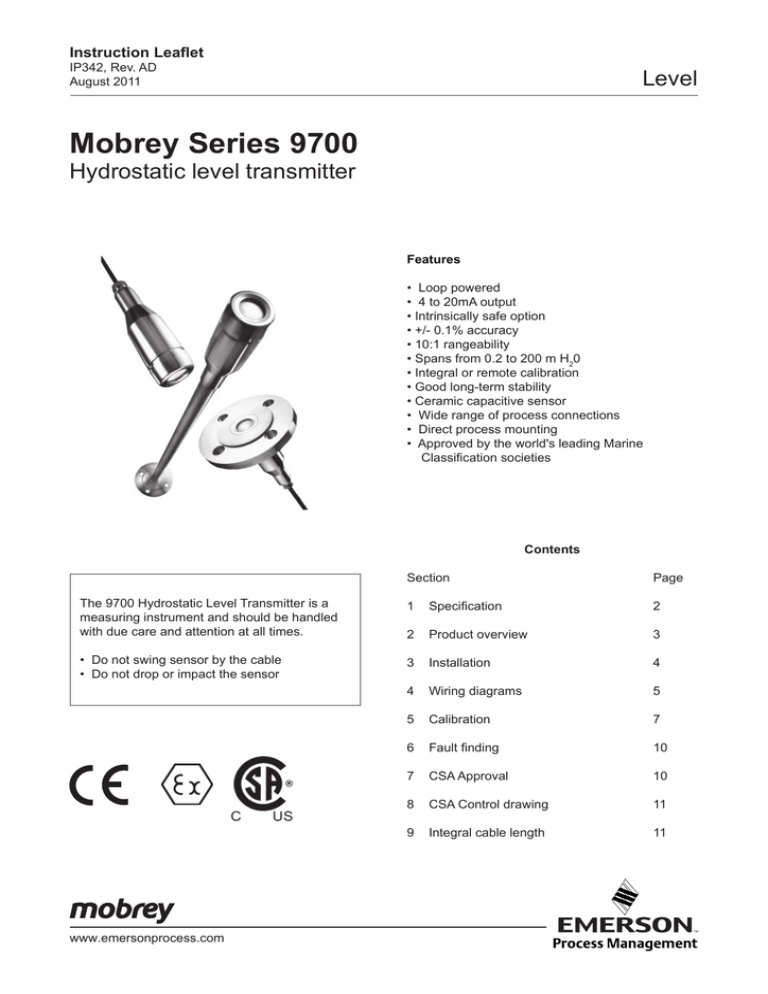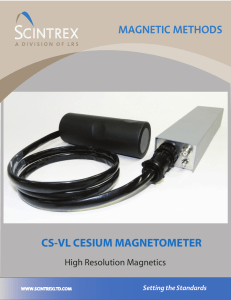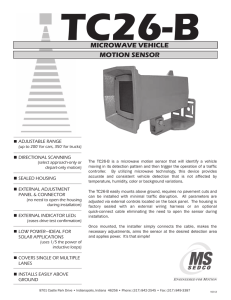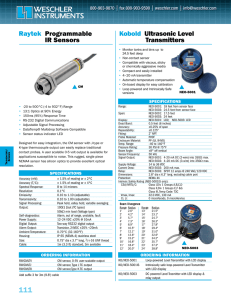
Instruction Leaflet
IP342, Rev. AD
August 2011
Level
Mobrey Series 9700
Hydrostatic level transmitter
Features
• Loop powered
• 4 to 20mA output
• Intrinsically safe option
• +/- 0.1% accuracy
• 10:1 rangeability
• Spans from 0.2 to 200 m H20
• Integral or remote calibration
• Good long-term stability
• Ceramic capacitive sensor
• Wide range of process connections
• Direct process mounting
• Approved by the world's leading Marine
Classification societies
Contents
Section
Page
The 9700 Hydrostatic Level Transmitter is a
measuring instrument and should be handled
with due care and attention at all times.
1
Specification
2
2
Product overview
3
• Do not swing sensor by the cable
• Do not drop or impact the sensor
3
Installation
4
4
Wiring diagrams
5
5
Calibration
7
6
Fault finding
10
7
CSA Approval
10
8
CSA Control drawing
11
9
Integral cable length
11
www.emersonprocess.com
Page 1
Section 1 : Specification
Functional
9710, 9720, 9780
Suspended in tank
9790
External to tank
Output signal :
Power supply :
Load resistance :
Measuring ranges :
Two-wire, 4-20mA
10-30V d.c.
R = 50 x (supply voltage -10V)
Up to 200m / 8" to 656ft H20
Two-wire, 4-20mA
10 - 30V d.c.
R = 50 x (supply voltage -10V)
Up to 200m / 8" to 656ft H20
Overrange limit :
Max 600m / 1968ft H20
Max 600m / 1968ft H20
Span adjustments :
Process temp. limits :
(non certified)
+10 to 100% URL*
-20 to + 60°C / -4 to +140°F
+10 to 100% URL*
-20 to + 90°C (80°C Ex ia)
Ambient temp. limits :
Humidity limits :
-20 to + 60°C
0 to 100% RH
-20 to + 60°C
0 to 100% RH
Hazardous area use :
ATEX II 1 G EEx ia IIB T4
CSA (Canada & USA)
Capacitance 500 pF/metre
Refer to Section 4
ATEX II 1 G EEx ia IIB T4
CSA (Canada & USA)
Capacitance 500p F/metre
Refer to Section 4
9710, 9720, 9780
Suspended in tank
9790
External to tank
+/- 0.1% (BSL)** of calibrated span
+/- 0.1% URL* per 6 months
+/- 0.015% URL per °C
See Section 5.5
+/- 0.1% (BSL)** of calibrated span
+/- 0.1% URL* per 6 months
+/- 0.015% URL per °C
See Section 5.5
9710, 9720, 9780
Suspended in tank
9790
External to tank
Process connection :
Submersible
Flange mounted
Wetted Parts :
Sensor :
Sensor Housing :
Sensor 'O' Rings :
Ceramic
316 St. Steel or Aluminium Bronze
Fluorocarbon (FPM/FKM) Nitrile
Ceramic
316 St. Steel or Aluminium Bronze
Fluorocarbon (FPM/FKM) Nitrile
Body 'O' Rings
Fluorocarbon (FPM/FKM) or Nitrile
Fluorocarbon (FPM/FKM) or Nitrile
Cable Seals
Fluorocarbon (FPM/FKM) or Nitrile
Fluorocarbon (FPM/FKM) or Nitrile
Cable :
Polyurethane or FEP coated
Polyurethane or FEP coated
Pole :
316 Stainless steel pole supplied
with 316 Stainless steel housing
option. Copper Nickel pole supplied
Aluminium Bronze Housing option
Not applicable
Ingress Protection :
Approximate weight :
IP68 / NEMA 6P (200m / 656ft H20)
0.7Kg / 1.54lbs (sensor only)
IP68 / NEMA 6P (200m / 656ft H20)
0.7Kg / 1.54lbs (sensor only)
Cable specification :
Performance
Accuracy :
Stability :
Temperature effect :
Response time :
Physical
* URL = Upper range limit
** BSL = Best straight line, includes effects of linearity, hysteresis & repeatability
Remote Enclosures
Remote enclosure :
Bellows enclosure :
Page 2
Aluminium IP67 Grey (RAL 7001) 0.7 kg
Polyester IP67 Grey (RAL 7001) 1.2 kg
Protected from aggressive environments and
processes
The transmitter is designed to withstand the
harshest of environments.
Its rugged, flush ceramic sensor is inherently
capable of withstanding attack from most
chemicals.
Range
Tank must be
vented
48mm / 1.89" dia
Mounting options
The 9700 is available in various mounting
configurations, all are rated IP68.
•
•
•
•
9710 - Cable suspended
9720 - Clamped, cable suspended
9780 - Pole mounted
9790 - Flanged
•
Threaded mounting is available upon request
9790 Flanged
190mm / 7.5" max.
Typical installation
In order to simplify installation, all 9700 series
transmitters can be supplied with remote zero and
span.
9710 Cable
suspended
165mm /
6.5"
Range
Remote zero and span allows zero and full scale
output to be set without removing sensor from
process, this option includes an IP67 junction box.
Bellows
For humid environments or sea water applications
bellows must be selected. (Option 4 of zero and
span)
Zero
Span
Zero and span
optional
8888
24V dc
Power
supply
(optional)
48mm / 1.89" dia
Range
4-20mA
9780 Pole mounted
Vented tank
Range
Simple installation, low maintenance
The 9700 is available in both submersible versions
and externally mounted (floodable) versions.
The housing contains the capacitive ceramic
sensor and the electronics circuit board, all the
components needed to produce an accurate
and reliable measurement of the process. The
glanding system used with the submersible
versions ensures absolute integrity of the IP68
/ NEMA 6P rating. IP68 / NEMA 6P units are
generally factory fitted with the required length of
vented cable fitted.
Pole length
Section 2 : Product Overview
9720 Clamped,
Cable
suspended
110 or
240V
Typical installation
300mm / 12" min.
Page 3
Section 3 : Installation
When installed in an explosive
atmosphere refer to ATEX Safety
Instructions IP341/SI and CSA control drawing
71907/1167 in Section 7.
3.2
Cable and termination
Submersible 9700 units are supplied fitted with
a specified length of vented cable. In the case
of units with integral electronics this should be
terminated in a vented box. For units with remote
electronics the vented cable is terminated in the
remote electronics box.
For connection diagrams see Section 4. For
applications where a long cable run is required
when using integral transmitters, the use of a
vented terminal box to be mounted in the nearest
clean and dry area to the tank, and standard 2
core screened cable from the terminal box can
often reduce cabling costs.
Terminate the cable screen to an appropriate
earth point. This connection should be inspected
periodically to ensure an effective contact.
3.1
Installation considerations
The ceramic capacitive sensor is extremely
rugged, however, care should be taken to avoid
physical impact of solid objects onto the sensor
face. Care should be taken, particularly in the
case of series 9710, 9720 and 9780 submersible
transmitters when lowering them into a tank, that
solid objects resting on the bottom of the vessel
are not in direct contact with sensor face, as this
will cause large errors.
The use of Aluminium Bronze sensors is strongly
recommended for application on any tanks
that may contain seawater or brine to avoid the
corrosive effects that may be caused by stray
currents. Always check that the sensor being fitted
is of the correct material for the application.
All 9700 units should be installed well away from
tank inlets, pumps and areas of tubulence or
pressure surges, as these can cause errors or
even damage the sensor.
9710 units may be suspended from the cable
provided. However, in moving tanks, such as
found in Marine applications, the sensor should be
clamped or fixed such that damage from impacts
or shock are avoided.
9790 flanged units: Ensure flange bolts are
tightened evenly and that mA o/p is stable and
correct prior to use.
Page 4
In excessively humid environments and all
shipboard applications, the cable must be
terminated in the control room, or other clean and
dry area, to minimise risk of moisture entering vent
tube and ultimately the sensor. If the transmitter
has been supplied with a remote electronics box,
then this box must be mounted in a clean and dry
area.
Alternatively the cable can be terminated into
the bellows box option which provides a sealed
venting system.
Ensure all cable glands are tight before use (see
Section 5)
1. DO NOT drag the sensor over sharp edges.
2. DO NOT swing the sensor by the cable.
3. DO NOT bend the cable to a radius of less than
80mm radius.
4. DO check cable sheathing for signs of damage
(cuts, weld spatter, burns etc.) particularly inside
the tank area. Damage to the sheathing will allow
process fluid to leak inside the transmitter.
3.3
Re-Ranging
All transmitters are factory calibrated over the
range stated on the label on the transmitter.
In most instances, if re-ranging is required, it is
carried out elsewhere in the 4 - 20mA loop (e.g.
the indicator, PLC or controller).
If the transmitter has been ordered with a
factory fitted remote electronics option, then the
transmitter may be re-ranged on site by removing
the cover of the remote electronics box to give
access to the adjustment potentiometers (See
section 5 for full details).
All other models have factory fitted cables and are
factory sealed - re-ranging of the transmitter is not
recommended as it will require breaking of the
factory seals.
Section 4 : Wiring Diagrams
Page 5
Page 6
Section 5 : Series 9700 calibration
All transmitters are factory calibrated over the
range stated on the label on the transmitter.
In most instances, if re-ranging is required, it is
carried out elsewhere in the 4 - 20mA loop (e.g.
the indicator, PLC or controller).
For Series 9710, 9720, 9780, 9790 with remote
electronics, simply undo the 4 screws on the front
of the cover to gain access to the PCB.
When calibrating series 9700 pressure and level
transmitters with remote electronics, the following
procedure should be followed:
NOTE : All 9700 Series Units are generally
supplied pre-calibrated and ranged specifically for
the application details supplied with the order.
Connect transmitter to the multimeter as shown
below.
For Series 9710, 9720, 9780, 9790 with integral
electronics, re-calibration and re-ranging is
not permitted by customer without invalidating
warranty.
Single loop may grounded
At any single point or left ungrounded
Electronics housing top view (cover removed)
Page 7
5.1
Re-ranging transmitter
5.3.3
Ensure transmitter is isolated from the
process and at zero pressure.
5.1.1
Verify sensor range from range code
shown on sensor body.
5.3.4
Turn potentiometer “SN” until multimeter
reads 0.00 millivolts, disconnect
multimeter and seal the 'SN'
potentiometer. Zero and span may now
be set as detailed in section 5.2.
5.4
Linearisation procedure
5.4.1
This is normally factory set and the
potentiometer sealed.
ON NO ACCOUNT MUST THE SEAL BE
BROKEN.
5.4.2
If the electronics have been changed
linearisation may be required. Only on
replacement electronics assemblies will
the linearisation potentiometer not be
sealed.
5.1.2
Connect 24v dc to transmitter. (12 to 30V
for standard units and 10 to 30V for I.S.
units)
5.1.3
Connect multimeter between power supply
and transmitter or to link 2 as shown in
diagram on Page 7.
5.1.4
Turn potentiometer “ZF” (fine zero
adjustment) until multimeter reads
4.000mA +/- 0.005mA.
5.1.5
With 100% pressure / level applied, turn
potentiometer “SC” (coarse span
adjustment) until multimeter reads
approximately 20mA.
5.1.6
Turn potentiometer “SF” (fine span
adjustment) until multimeter reads
20.000mA +/-
5.1.7
Return pressure / level to 0%, multimeter
should now read 4.000mA +/- 0.005mA.
5.1.8
Transmitter is now calibrated and ready for
service.
5.2
Zero offset
5.2.1
For an offset zero (i.e.) lower range
pressures between 20% of span below
atmospheric pressure and 40% of span
above atmospheric pressure it is
recommended that the transmitter span is
first set as in section 5.1.
5.2.2
The zero offset required can now be
introduced by using ZF. This prevents
zero / span interaction when the sensor is
“off null”.
5.3
Sensor null (Normally factory set) :
Replacement electronics only
NOTE: This is normally factory set and
sensor null potentiometer will be sealed.
ON NO ACCOUNT MUST THE SEAL BE
BROKEN.
5.3.1
If the electronics have been changed, the
sensor null (SN) will require adjustment.
Connect multimeter between TP1 and TP2
using 1mm test pins.
5.3.2
Set multimeter to millivolt range.
Page 8
In this case having carried out the sensor nulling
procedure first, the transmitter can then be
linearised before being re-ranged.
5.4.3
Apply a pressure of 50% of nominal range.
Observe percentage error and use
graph to determine adjustment required on
'LIN' potentiometer, e.g. for an error of
-0.1% turn LIN pot anti-clockwise by half a
turn.
5.4.4
The linearisation potentiometer should
now be sealed.
5.4.5
The transmitter can now be re-ranged as
in Section 5.2.
Linearity Adjustment Chart
5.5
Sensor response time
5.5.1
The sensor damping can be adjusted via
link 1 as shown below.
Electronics housing top view (cover removed)
5.5.2
With link 1 present the response time is
approximately 60mS for a 63% response
to pressure change and 150mS for a 90%
response to pressure change.
5.5.3
With link 1 removed the response times
become approximately 10mS for a 63%
response to pressure change and 90mS
for a 90% response to pressure change.
5.6
Re-assembly of the sensor
Refer to Section 5.0.
Units are supplied with link 1 fitted.
Page 9
Section 6 : Fault Finding
6.1
The following is a guide to simple fault
finding
6.1.1
Lightning
HIGH mA OUTPUT
NO CHANGE IN OUTPUT WITH
PRESSURE CHANGE.
REMEDY : Return to factory.
Fit new main circuit board and recalibrate
as in Section 5.
6.1.2
Moisture Condensation
FLUCTUATING OUTPUT,
CHANGING IN
STEADY SIGNAL OUTPUT
APPROX. 4 mA. NO CHANGE IN
OUTPUT WITH PRESSURE CHANGE.
6.3
Remote transmitters
By connecting a Multimeter between
terminal 4 (the OV white) and the following
terminal in the remote transmitter, the
given voltages should be observed.
(See drawing no. F1524 in Section 4 for
terminal details).
1.
Blue
+1.235V (nominal) reference from
middle PCB
May be between +1.21V and
+1.26V.
2.
Green
+8.5V semi-stabilised from middle
PCB.
May be between +8 and +9 volts.
3.
Yellow
4.
White
+5V supply from middle PCB to
ceramic sensor. Varies with span,
temperature compensation and
linearity correction but will
nominally be around +5.0V or
+4.85V at 25°C.
OV common
5.
Red
Ceramic pressure sensor output.
Nominally +1 volt at zero pressure
and +4 volts at full
pressure (equal to nominal range
of the sensor).
6.
Black
Temperature output from bottom
PCB. Nominally +1.235V at 25°C
but will vary between +1.1 volts
and +1.5 volts over the
compensated temperature range
of -20°C to +90°C.
REMEDY : Remove the transmitter to a
dry area and allow it to fully dry out.
6.1.3
Damaged Sensor
HIGH mA OUTPUT (VOLTAGE
OUTPUT SENSOR) APPROX.
>10mA.
NO CHANGE IN OUTPUT WITH
PRESSURE CHANGE.
REMEDY : Return to factory. Replace
sensor
6.2
Replacing main circuit board assembly
For Series 9710, 9720, 9780, 9790 it
is recommended that the main circuit
board assembly is only changed by a
qualified service engineer.
Section 7 : Approvals
Hazardous Area Certification :
ATEX II 1 G
ATEX II 1 GD (available upon request)
EEx ia IIB T4 Intrinsically Safe
CSA (Canada & USA)
CLI, DIV1, GPS C & D
CL II DIV1, GPS E, F & G, CL III
Ex ia IIB T4
AEx ia IIB T4
Page 10
Marine Approvals :
Lloyds Register
Bureau Veritas
American Bureau of Shipping
Korean Register
Germanisher Lloyd
DNV
Section 8 : CSA Control drawing
Section 9 : Integral cable length for intrinsically safe systems
In calculating the permissible capacitance for an
intrinsically safe system, the cable supplied with
the equipment must be taken into consideration.
405
Total Capacitance (nF)
Integral electronics:
The value of Ci (378nF) must be increased by
0.25nF for each metre of integral cable fitted
above 120m
9700 Integral
400
395
390
385
380
375
Remote electronics:
The value of Ci (378nF) must be increased by
1.2nF for each metre of cable above 25m between
the the sensor head and the remote electronics.
Remote units
For L ≤ 25m, C = 378nF
For L > 25m, C = 378 + 1.2(L - 25) nF
(L = length of integral cable in metres)
50
100
150
200
250
Integral cable length (m)
9700 Remote
625
Total Capacitance (nF)
Integral units
For L ≤ 120m, C = 378nF
For L > 120m, C = 378 + 0.25(L - 120) nF
(L = length of integral cable in metres)
0
575
525
475
425
375
0
50
100
150
200
250
Integral cable length
Page 11
Instruction Leaflet
Level
The Emerson logo is a trade mark and service mark of Emerson Electric Co.
Mobrey is a registered trademark of Rosemount Measurement Ltd.
All other marks are the property of their respective owners
We reserve the right to modify or improve the designs or specifi cations of product and services at any time without notice.
© 2011 Rosemount Measurement Ltd. All rights reserved.
International:
Emerson Process Management
Rosemount Measurement Ltd.
158 Edinburgh Avenue
Slough, Berks, SL1 4UE, UK
T +44 1753 756600
F +44 1753 823589
www.emersonprocess.com
IP342, Rev. AD
August 2011





